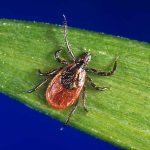What Birders Need to Know about Ticks
“What birders need to know about ticks” is the title of the Redbud Audubon Zoom presentation scheduled for March 21, starting at 7 p.m. Registration for the program can be accomplished by going to the Redbud Audubon Society website: www.redbudaudubon.org or by clicking on the link in this newsletter.
Presenting this important and interesting topic is Dorothy Leland, President of LymeDisease.org, a national Lyme disease education and advocacy organization.
“Birders are at high risk for Lyme disease,” says Leland. “Standing outside in nature,  walking through grassy fields and wooded areas, sitting on fallen logs, leaning against trees—all of these activities put you right where the ticks are.”
walking through grassy fields and wooded areas, sitting on fallen logs, leaning against trees—all of these activities put you right where the ticks are.”
Protecting yourself starts with learning about what ticks are and where they live, Leland says.
Ticks are tiny spider-like bugs often found in wooded and grassy areas. There are different kinds of ticks, which can carry many different diseases. The most common tick-borne infection in the United States is Lyme disease.
According to estimates by the Centers for Disease Control and Prevention, about a half-million people become infected with Lyme disease in the US every year.
The illness may start with flu-like symptoms, such as headaches, fatigue and fever. Sometimes, although not always, there is a “bull’s-eye” rash. If you do have Lyme, this is the point where you want to be diagnosed and treated, before the microbe burrows into your body and creates long-term problems.
If not caught and treated early, Lyme disease can affect practically every system of the body. It can cause debilitating joint pain, crushing fatigue, insomnia, gastrointestinal dysfunction, life-threatening heart conditions, neurological symptoms and psychiatric disorders – to name a few. In children, it may also trigger learning disabilities and behavioral issues.
Unfortunately, many who are infected do not get promptly diagnosed and treated. People with Lyme disease may instead be told they have fibromyalgia, chronic fatigue syndrome, rheumatoid arthritis or Alzheimer’s – all conditions that Lyme disease can mimic. They may also experience depression, without realizing their condition is caused by Lyme disease. So, what’s a person to do?
“I’ll give details on ways to protect yourself,” says Leland. “The short version is: Wear protective clothing and repellents, check your body for ticks often and properly remove any attached ticks you may find.”
Leland became involved with Lyme disease advocacy when her daughter contracted it at age 13. It took almost a year to get properly diagnosed and begin treatment and many more years to recover her health.
As President of LymeDisease.org, Leland advocates nationally for Lyme disease patients. In 2015, she co-authored the book When Your Child Has Lyme Disease: A Parent’s Survival Guide. In 2023, she co-authored a book with her daughter, Rachel, called Finding Resilience: A Teen’s Journey Through Lyme Disease. It’s based on the journal Rachel kept as a young teen during the hardest years of her illness.
Dorothy Kupcha Leland is president of LymeDisease.org, a national research and patient advocacy organization. She writes the blog Touched by Lyme and is co-author of two books about Lyme disease: When Your Child Has Lyme Disease: A Parent’s Survival Guide and Finding Resilience: A Teen’s Journey Through Lyme Disease. She lives in Davis, CA.





